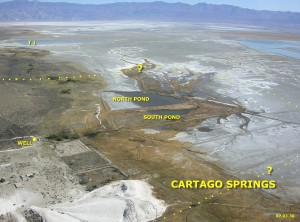Since the Department of Water and Power started shallow flooding portions of the Owens Lake to control dust in 2001, wildlife has returned in force.
 With over 50,000 birds counted on a single springtime day, the California Audubon Society has designated the Owens Lake dust control project as one of the most important bird areas of the state, a fact mentioned in an article in a recent Sunday edition of the Los Angeles Times.
With over 50,000 birds counted on a single springtime day, the California Audubon Society has designated the Owens Lake dust control project as one of the most important bird areas of the state, a fact mentioned in an article in a recent Sunday edition of the Los Angeles Times.
The Audubon Society offers a number of criteria for listing important bird areas, but local Audubon member Mike Prather says that they are places that, we could not afford to lose.
Every spring, birds fly through the Owens Valley on their annual migration that can take the creatures from South America to the Arctic. With newly watered areas of the lake bed, dry since the Owens River was diverted south, the birds have returned along with the brine flies that ring the shallow flooded ponds.
This year, when volunteers and DWP biologists headed to the lake for a spring bird count, the number came back at an estimated 62,100 birds of 75 different species.
While the wildlife goes about its business on the lake bed, there is a larger political question among the people, who are working to decide the future of the dust control project, (DWP, Great Basin Air Pollution Control, the State Lands Commission, and other groups.)
The original purpose of the water on the lake bed was to control dust. Great Basin Air Pollution Control has allowed the Department of Water and Power to use gravel on the roads, plants, and water to keep the dust down, but water is the most widely used.
In an effort to limit or reduce the amount of water that would otherwise be used by the residents of the City of Los Angeles, (reported to be about 87,000 acre feet a year on the lake) the Department is looking for other ways to keep the dust down with out using so much river water. One plan in the works is to possibly pump ground water from underneath the lake bed to fill the shallow flood areas. The other method under review is called moat and row, which tills the soil to look like big garden rows that create lee spaces for the dust to drift into.
Whether the Department will be allowed to use moat and row to control dust on the lake bed and what this means to the water that currently supports this new habitat is yet to be seen.

















